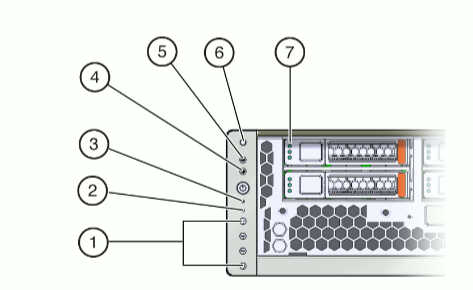
| Home | Current Systems | Former STK Products | EOL Systems | Components | General Info | Search | Feedback |

|
Oracle System Handbook - ISO 7.0 May 2018 Internal/Partner Edition | ||
|
|||
Netra SPARC S7-2 LEDsThe Netra SPARC S7-2 server provides the following LED groupings:
Front Panel LEDs
Rear Panel LEDs | |||||||||||||||||||||||||||||||||||||||||||||||||||||||||||||||||||||||||||||||||||||||||||||||
| LED Name | LED Color | Description |
|---|---|---|
| 1. Power Supply Status LED | Output Power OK LED - Top, Green | Indicates that output power is without fault. |
| Service Required LED - Amber | Indicates that service fro the power supplu is required. POST and Oracle ILOM are two diagnostic tools that can detect a fault or failure resulting in this section. | |
| 2. NET 0 to NET3 Status LEDs | Amber - On or Blinking | A link is established. |
| Amber - Off | No link is established. | |
| 3. NET MGT Status LED | Green - On | A link is established. |
| Green - Blinking | There is activity on the link. | |
| Green - Off | No link is established. | |
| 3. Speed LED | Green | The link is operating as a 10000-Mbps connection. |
| Amber | The link is operating as a Gigabit connection (1000-Mbps). | |
| Off | The link is operating as a 100-Mbps connection or there is no link. | |
| 4. Chassis Status LED - Locator LED and button | Left, White |
The locator can be turned on to identify a particluar system. When on, the LED blinks rapidly. There are two methods for turning a Locator LED on: 1. Typing the Oracle ILOM command set /SYS/LOCATE value = Fast_Blink. 2. Pressing the Locator button.
|
| 4. Chassis Status LED - Service Required LED | Center, Amber |
Indicates that service is required. POST and Oracle ILOM are two diagnostics tools that can detect a fault or failure resulting in this indication. The Oracle ILOM show faulty command provides details about any faults that cause this indicator to light. Under some fault conditions, individual component fault LEDs are turned on in addition to the Service Required LED. |
| 4. Chassis Status LED - Power OK LED | Green - Off | Server is not running in its normal state. System power might be off. The SP might be running. |
| Green - Steady On | Server is powered on and is running in its normal operating state. No service actions are required. | |
| Green - Fast Blink | Server is running in Standyby Mode and can be quickly returned to full function. | |
| Green - Slow Blink | Normal but transitory activity is taking place. Slow blinking might indicate that system diagnostics are running or that the server is booting. |
|
Copyright © 2018 Oracle and/or its affiliates. All rights reserved. Feedback | |||